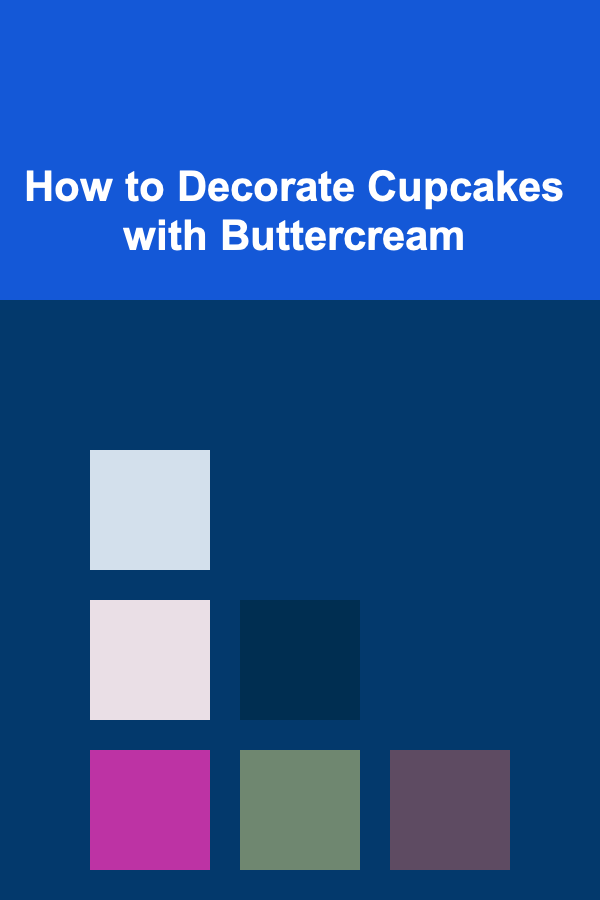
How to Decorate Cupcakes with Buttercream
ebook include PDF & Audio bundle (Micro Guide)
$12.99$11.99
Limited Time Offer! Order within the next:

Decorating cupcakes with buttercream is an art that blends creativity with technical skill. Cupcakes are popular because of their individual serving size, their versatility in flavor and design, and their appeal to a wide range of occasions. Whether you're preparing cupcakes for a wedding, birthday, holiday, or casual gathering, the process of decorating them with buttercream can transform simple cupcakes into beautiful, customized works of edible art. This article will guide you through everything you need to know about decorating cupcakes with buttercream, from the basics of buttercream frosting to more advanced decorating techniques.
The Basics of Buttercream
Before we dive into the actual decorating process, it's essential to understand what buttercream is, the different types of buttercream, and how to make it. Buttercream is a type of frosting made primarily from butter and powdered sugar, though there are many variations depending on the recipe.
Types of Buttercream
There are several types of buttercream, each offering different textures and flavor profiles. The most common types are:
1. American Buttercream
American buttercream is the easiest and most commonly used frosting. It's made with butter, powdered sugar, a little bit of milk, and vanilla extract. American buttercream is sweet, creamy, and easy to make, making it perfect for beginners.
2. Swiss Meringue Buttercream
Swiss meringue buttercream is lighter and silkier than American buttercream. It's made by heating egg whites and sugar to a certain temperature, then whipping them into a meringue before adding butter. The result is a smoother, less sweet buttercream with a more refined taste.
3. Italian Meringue Buttercream
Italian meringue buttercream is similar to Swiss meringue but uses a sugar syrup that's heated to a higher temperature before being poured into the egg whites to create a meringue. This type of buttercream is even more stable than Swiss meringue buttercream and is less likely to separate in warm conditions.
4. French Buttercream
French buttercream is rich and silky, made with egg yolks, sugar, and butter. It has a custard-like texture and is less sweet than American buttercream. This variety is excellent for those looking for a more luxurious frosting.
5. Cream Cheese Frosting
Cream cheese frosting is made with cream cheese, butter, powdered sugar, and vanilla. While it's not technically a buttercream, it has a similar texture and is often used to frost cupcakes, especially for flavors like carrot cake or red velvet.
How to Make American Buttercream
Since American buttercream is the most popular and versatile, let's focus on how to make it. Here's a simple recipe:
Ingredients:
- 1 cup (2 sticks) unsalted butter, softened
- 4 cups powdered sugar
- 1-2 tablespoons milk (or heavy cream for a richer texture)
- 2 teaspoons vanilla extract
- Pinch of salt
Instructions:
- Cream the Butter: In a large mixing bowl, beat the butter using a hand mixer or stand mixer on medium speed until smooth and creamy, about 2 minutes.
- Add Powdered Sugar: Gradually add the powdered sugar, 1/2 cup at a time, beating on low speed to avoid a sugar cloud. Once all the powdered sugar is incorporated, beat on medium-high for about 3-5 minutes until the frosting is light and fluffy.
- Add Milk and Vanilla: Add the milk (or cream), vanilla extract, and salt. Continue to beat until the frosting reaches your desired consistency. Add more milk for a thinner frosting, or more powdered sugar for a thicker one.
- Coloring the Buttercream (Optional): If you want to color your buttercream, divide it into separate bowls and add food coloring a drop at a time until you achieve the desired color. Gel food coloring is recommended because it's more concentrated and doesn't affect the consistency as much as liquid food coloring.
Once you've prepared your buttercream, it's time to start decorating!
The Tools You'll Need
To achieve beautiful cupcake decorations, you'll need a few basic tools. Here's a list of essentials:
- Piping Bags: These are essential for piping buttercream onto cupcakes. Piping bags come in various sizes, but a standard 12-inch bag should be sufficient for most decorating tasks.
- Piping Tips: These are metal or plastic attachments for the piping bag that help shape the frosting as it is dispensed. There are various tips to create different designs, including star, round, petal, and leaf tips.
- Couplers: A coupler is a small piece of plastic that holds the piping tip in place on the piping bag. This allows you to easily switch out tips without changing the entire bag of frosting.
- Turntable: A turntable helps to rotate your cupcake or cake as you pipe, making it easier to work in a smooth, even manner.
- Offset Spatula: An offset spatula is perfect for smoothing out the frosting on cupcakes. It gives you better control and helps you avoid smearing frosting everywhere.
- Edible Decorations: These include sprinkles, edible glitter, candy pieces, or even edible flowers that can add extra flair to your decorated cupcakes.
Decorating Cupcakes with Buttercream
Basic Techniques
The simplest way to decorate a cupcake is by using a basic piped swirl or rosette. Below are step-by-step instructions for a few basic techniques that will help you get started.
1. Simple Piped Swirl
One of the easiest ways to decorate a cupcake is by creating a simple swirl of buttercream. Here's how:
- Prepare your Piping Bag: Insert a piping tip (such as a star tip, #1M or #2D), and fill the piping bag with buttercream.
- Start in the Center: Hold the piping bag directly above the center of the cupcake. Begin by squeezing out a small amount of frosting to start the swirl.
- Build the Swirl: Continue to pipe the frosting in a circular motion, starting from the center and spiraling outward until you reach the edge of the cupcake. Finish the swirl by releasing the pressure on the piping bag and gently lifting the tip away.
2. Rosette Design
The rosette design is a more intricate version of the simple swirl. It creates a beautiful flower-like pattern that can be used for a more elegant look.
- Prepare your Piping Bag: Use a closed star tip like #2D or #1M.
- Create the Center: Begin by piping a small dot in the center of the cupcake.
- Pipe Petals: Using the same circular piping motion, create overlapping petals around the center. Start each petal near the center and pipe a swirl outward before returning to the center.
- Finish the Rosette: Continue building the rosette by adding more petals until the entire surface of the cupcake is covered. The result will be a beautiful, multi-layered rose design.
3. Piped Flowers
Creating piped flowers on cupcakes is another advanced decorating technique that will impress your guests. This method requires practice but can yield stunning results.
- Prepare your Piping Bag: Use a petal tip (like #104) for this design.
- Pipe the Base Petals: Start by piping the first petal in the center of the cupcake, holding the piping bag at a 45-degree angle. Gently squeeze the frosting and pull the bag toward the edge of the cupcake to form the petal.
- Pipe Additional Petals: Continue piping petals in a circular motion, slightly overlapping each one. Gradually build the flower outward, working with the shape of the petals.
- Finishing Touches: You can add an additional layer of frosting or smaller decorative flowers in the center of your flower to create depth.
Advanced Techniques
Once you've mastered the basic techniques, you can experiment with more advanced designs, such as ombre frosting, floral arrangements, and intricate piping.
1. Ombre Buttercream
Ombre frosting is a gradient effect where the color of the frosting transitions from light to dark. It's visually striking and works well for all occasions.
- Divide the Buttercream: Divide the buttercream into three or more bowls. Add a small amount of food coloring to each bowl to create a light, medium, and dark shade.
- Fill the Piping Bag: Using a spoon, add a spoonful of the darkest buttercream to one side of the piping bag. Add the medium-colored buttercream next to it, and then add the lightest buttercream on the other side.
- Pipe the Cupcakes: When you pipe the buttercream, it will create a seamless transition from dark to light. The more distinct the layers in the bag, the more noticeable the ombre effect will be.
2. Buttercream Flowers and Leaves
In addition to piped roses, you can also create detailed buttercream flowers such as daisies, sunflowers, and chrysanthemums. These intricate designs require a steady hand and knowledge of various piping techniques.
- Daisies: Use a daisy petal tip to pipe each individual petal and arrange them in a circular pattern around a small center.
- Sunflowers: Pipe yellow petals around a brown center. You can use a leaf tip to add green leaves and create a more natural look.
Conclusion
Decorating cupcakes with buttercream is a creative and enjoyable way to add personal flair to your baked goods. With a basic understanding of the different types of buttercream, the right tools, and a few key decorating techniques, you can create beautiful cupcakes for any occasion. Whether you're aiming for a simple swirl, an elegant rosette, or intricate piped flowers, the possibilities are endless. Keep practicing, and soon you'll be decorating cupcakes like a pro, impressing friends and family with your edible works of art.

How to Maximize Space in Tiny Bathrooms with Storage Hacks
Read More
How to Plan for Major Life Events Without Breaking the Bank
Read More
How to Set Up a Cat Litter Box Area That Minimizes Odor
Read More
How To Pick the Perfect Coming-of-Age Story
Read More
Mastering Any Musical Instrument: A Deep Dive
Read More
How to Get Started with Circuit Training: A Comprehensive Guide
Read MoreOther Products

How to Maximize Space in Tiny Bathrooms with Storage Hacks
Read More
How to Plan for Major Life Events Without Breaking the Bank
Read More
How to Set Up a Cat Litter Box Area That Minimizes Odor
Read More
How To Pick the Perfect Coming-of-Age Story
Read More
Mastering Any Musical Instrument: A Deep Dive
Read More